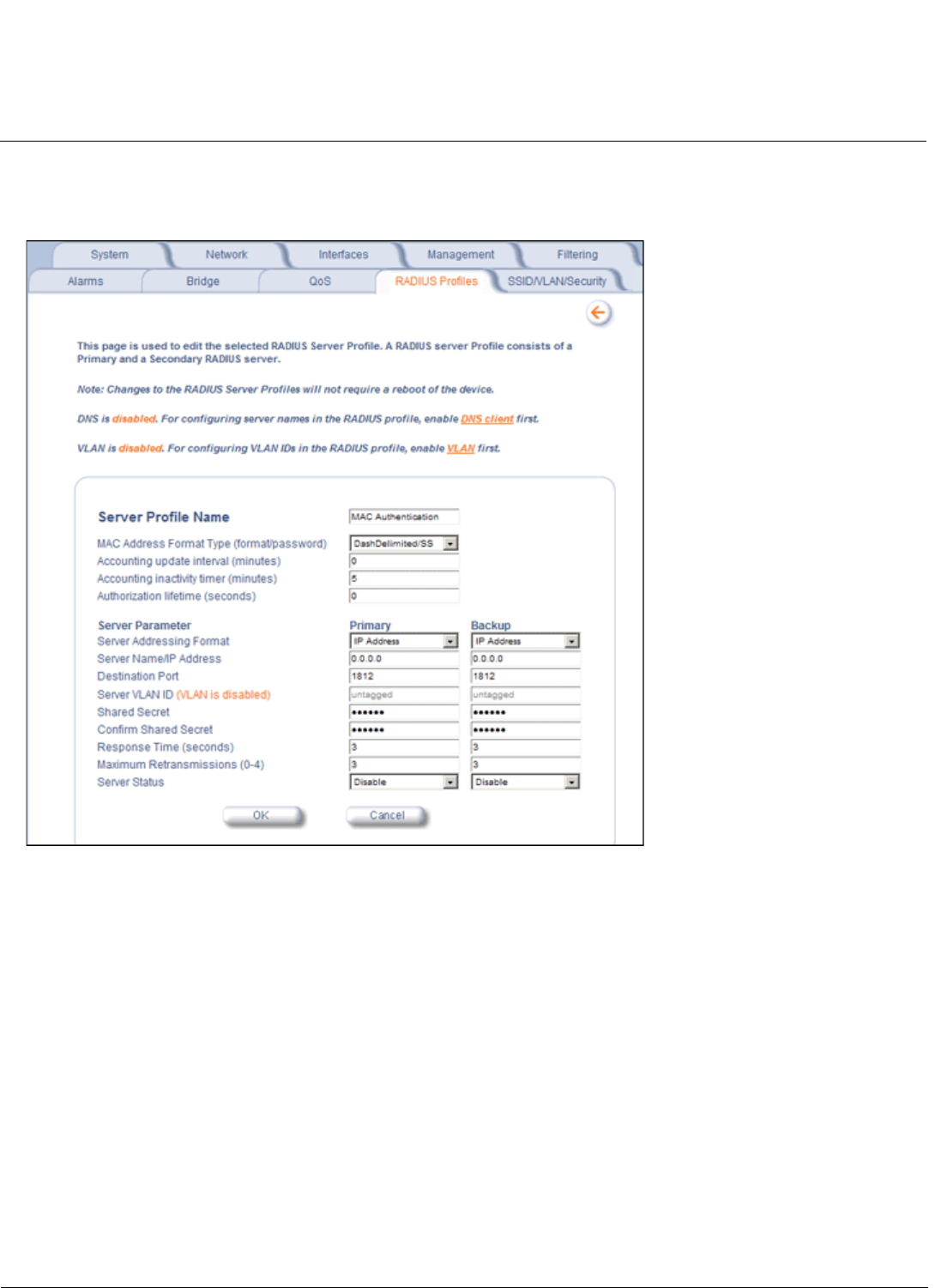User guide
Table Of Contents
- Introduction
- Installation and Initialization
- System Status
- Advanced Configuration
- System
- Network
- Interfaces
- Management
- Filtering
- Alarms
- Bridge
- QoS
- Radius Profiles
- SSID/VLAN/Security
- Monitoring
- Commands
- Troubleshooting
- Command Line Interface (CLI)
- General Notes
- Command Line Interface (CLI) Variations
- CLI Command Types
- Using Tables and Strings
- Configuring the AP using CLI commands
- Set Basic Configuration Parameters using CLI Commands
- Set System Name, Location and Contact Information
- Set Static IP Address for the AP
- Change Passwords
- Set Network Names for the Wireless Interface
- Enable 802.11d Support and Set the Country Code
- Enable and Configure TX Power Control for the Wireless Interface
- Configure SSIDs (Network Names), VLANs, and Profiles
- Download an AP Configuration File from your TFTP Server
- Backup your AP Configuration File
- Set up Auto Configuration
- Other Network Settings
- Configure the AP as a DHCP Server
- Configure the DNS Client
- Configure DHCP Relay
- Configure DHCP Relay Servers
- Maintain Client Connections using Link Integrity
- Change Wireless Interface Settings
- Set Ethernet Speed and Transmission Mode
- Set Interface Management Services
- Configure Syslog
- Configure Intra BSS
- Configure Wireless Distribution System
- Configure MAC Access Control
- Set RADIUS Parameters
- Set Rogue Scan Parameters
- Set Hardware Configuration Reset Parameters
- Set VLAN/SSID Parameters
- Set Security Profile Parameters
- CLI Monitoring Parameters
- Parameter Tables
- CLI Batch File
- ASCII Character Chart
- Specifications
- Technical Services and Support
- Statement of Warranty

Advanced Configuration AP-700 User Guide
Radius Profiles
101
NOTE: This page configures only the Primary RADIUS Server associated with the profile. After configuring these
parameters, save them by clicking OK. Then, to configure the Secondary RADIUS Server, edit the profile from
the main page.
Figure 4-44 Add RADIUS Server Profile
• Server Profile Name: the profile name. This is the name used to associated a VLAN to the profile. See
Configuring Security Profiles. The Server Profile Name is also used in the Configure > Management > Services
page to specify the RADIUS profile to be used for RADIUS Based Management Access.
• MAC Address Format Type: This parameter should correspond to the format in which the clients’ 12-digit MAC
addresses are listed within the RADIUS server and the way passwords are sent to the RADIUS server. Available
options are:
– Dash delimited/SS: MAC addresses are formatted with a dash between each pair of digits (xx-yy-zz-aa-bb),
and the password sent to the RADIUS server is the shared secret (configured below).
– Colon delimited/SS: MAC addresses are formatted with a colon between each pair of digits (xx:yy:zz:aa:bb:cc)
and the password sent to the RADIUS server is the shared secret (configured below).
– Single dash delimited/SS: MAC addresses are formatted with a dash between the sixth and seventh digits
(xxyyzz-aabbcc) and the password sent to the RADIUS server is the shared secret (configured below).
– No delimiters/SS: MAC addresses are formatted with no characters or spaces between pairs of hexadecimal
digits (xxyyzzaabbcc) and the password sent to the RADIUS server is the shared secret (configured below).
– Dash delimited/MAC: MAC addresses are formatted with a dash between each pair of digits (xx-yy-zz-aa-bb),
and the password sent to the RADIUS server is the MAC address of the client.










